International trade in services
Data extracted in January 2024.
Planned article update: January 2025.
Highlights
International trade in services with non-member countries (extra-EU), EU, 2010–2022
This article describes the major developments of international trade in services in the European Union (EU), and the EU Member States. Furthermore, it provides information about the EU’s main trading partners for services.
Full article
General overview
Services play an important role in all modern economies. A resilient tertiary service sector, as well as increased availability of services, may boost economic growth and enhance industrial performance. In an increasingly globalised world, services such as finance, insurance, transport, logistics and communications deliver key intermediate inputs and thereby provide crucial support to the rest of the economy.
Figure 1 presents the year-to-year development of the sum of exports and imports for the EU’s transactions of goods and services with non-member countries (in other words, trade outside of the EU, also known as extra-EU trade), for years 2001 to 2022; these data are based on quarterly balance of payments statistics. During this period, the EU’s volume of services transactions with non-member countries grew each year with the exception of 2003, 2009 and 2020. 2009 is the year in which the global financial and economic crisis was at its peak and the EU’s transactions in services fell by 8.3%. The significant dip in 2020 by 11.6% was due to the covid-19 pandemic and associated measures. The EU volume of services trade increased again in 2021 by 10.7%, as well as in 2022 by 22.9% (largest increase recorded in the entire period).
In the period from 2002 to 2022, the EU net surplus of services, in other words the value of exports minus the value of imports, was always positive, with a maximum of €207 billion in 2022. In the period from 2012 to 2016, growth for the EU’s international trade in services was higher than for international trade in goods, this trend reversed in 2017 but returned in 2018 and 2019. However in 2020 services recorded a higher drop than goods, and in 2021 and 2022 goods recorded a significantly higher growth rate than services.
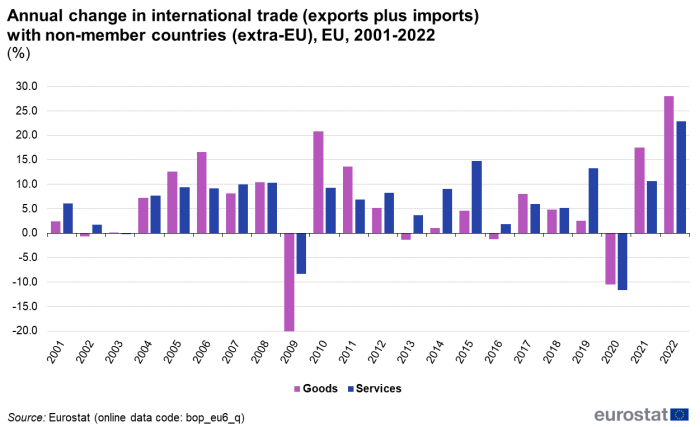
(%)
Source: Eurostat (bop_eu6_q)
From 2010 to 2019 the EU's exports of services to non-member countries increased every year, from €565 billion in 2010 to €1078 billion in 2019. As a result of the covid-19 pandemic, in 2020 exports dropped to €925 billion but in 2021 exports recovered with €1092 billion and reached €1361 billion in 2022. During the same period, EU imports of services from non-member countries progressed from €488 billion in 2010 to €1023 billion in 2019, before decreasing to €913 billion in 2020. In 2021 imports rebounded to 952 billion, reaching €1155 billion in 2022. (see Figure 2).

(€ billion)
Source: Eurostat (bop_its6_tot)
The 2022 data show that Germany was the EU Member State with the highest value of exports of services to non-member countries, its €237 billion of exports equivalent to 17% of the EU total — see Figure 3. The next highest levels of exports to non-member countries were recorded by Ireland (€231 billion or 17%), France (€179 billion or 13%) and the Netherlands (€135 billion or 10%). Ireland had the highest level of services imports from non-member countries with €278 billion or 24% of the EU total; Germany (€207 billion or 18%), France (€124 billion or 11%) and the Netherlands (€122 billion or 11%) followed.
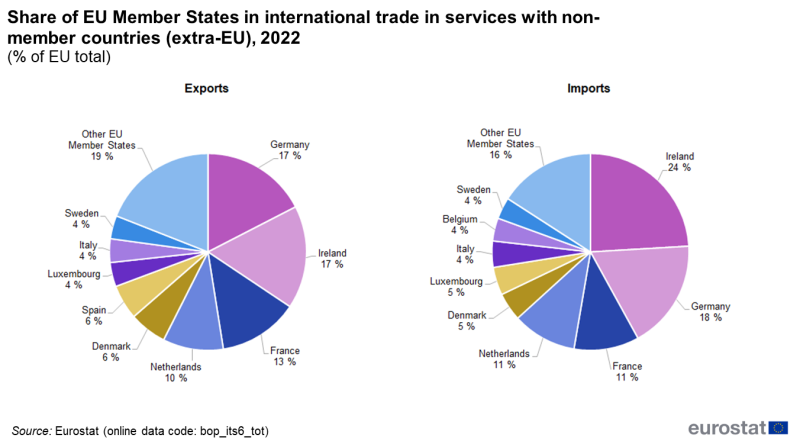
(% of EU total)
Source: Eurostat (bop_its6_tot)
Figure 4 presents the analysis of trade in services between EU Member States (intra-EU trade) — rather than with non-member countries. In 2022, Germany recorded the largest value of services exports to other EU Member States (€170 billion or 13%), followed by France (€148 billion or 11%) and the Netherlands (€146 billion or 11%). Again Germany was the largest importer of services from other EU Member States, with imports valued at €227 billion or 19%, ahead of France (€151 billion or 13%) and the Netherlands (€133 billion or 11%).
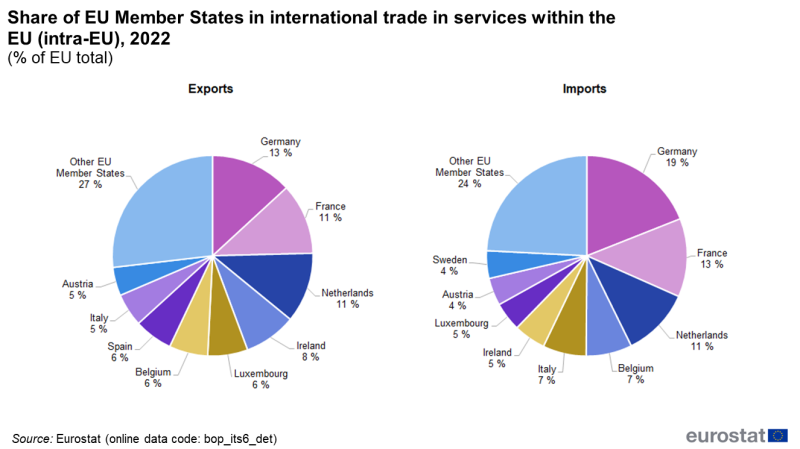
(% of EU total)
Source: Eurostat (bop_its6_tot)
In 2022, the division of total trade volume in services (sum of imports and exports) between trade with non-member countries on one hand and trade with other EU Member States on the other hand varied significantly among the EU Member States (see Figure 5). This reflected, to some extent, either the geographical proximity or historical trade associations. Hence, Ireland (75%) exhibited a large proportion of international trade in services transactions occurring outside the EU, as did Greece (64%) and Cyprus (63%).
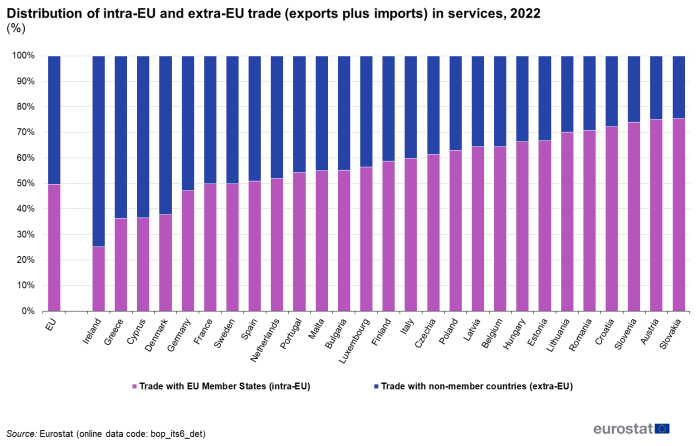
(%)
Source: Eurostat (bop_its6_tot)
At the other end of the spectrum, 75% of Slovakia and Austria's international trade in services transactions were recorded with other EU Member States, followed by Slovenia with 74%. For 2022, the EU average shows that 50% of all international services transactions took place within the EU, and 50% were with non-member countries.
Main trading partners
Figure 6 presents the EU’s main trading partners for services. Between 2021 and 2022 the EU’s exports and imports of services increased for all of its main partners.
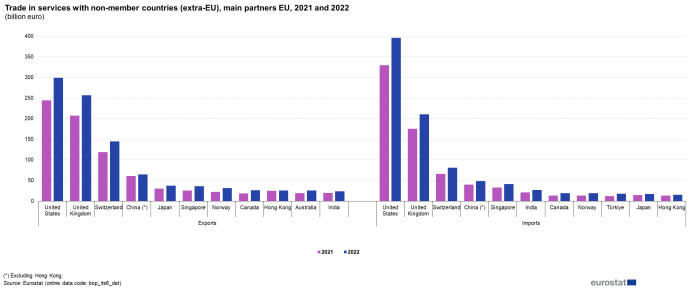
(€ billion )
Source: Eurostat (bop_its6_det)
Figure 7 shows the share of the main partners for services exports and imports. In 2022, the United States and the United Kingdom were the largest destination for EU exports of services, with trade valued at €299 billion and €257 billion respectively, representing 22% and 19% of all exports to non-member countries. The next largest destinations were Switzerland (11%) and China (5%). (see Figure 7) All the countries shown in Figure 7 collectively received about 71% of all exports of services from the EU to non-member countries in 2022.
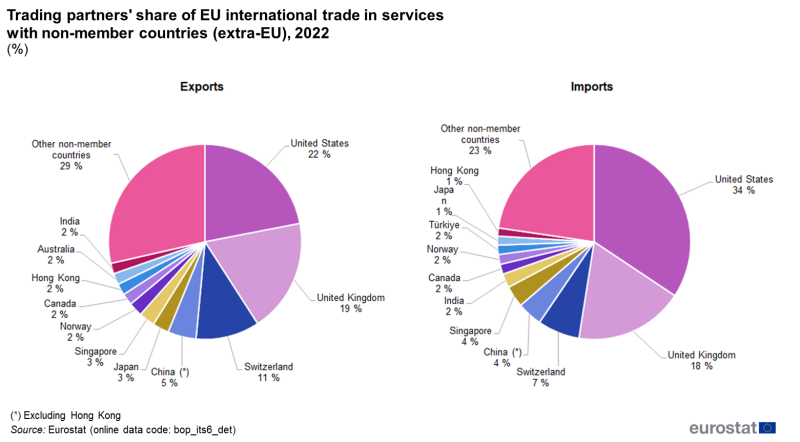
(%)
Source: Eurostat (bop_its6_det)
The top two countries of origin for EU imports of services were the same as the destinations with the two highest shares of EU exports of services. (see Figure 7) Again the United States accounts for the largest value of imported services, some €396 billion which is equivalent to 34% of the total imports from non-member countries. The next highest shares are from the United Kingdom with 18% and Switzerland with 7%. All the countries shown in Figure 7 collectively account for about 77% of all EU services imported from non-member countries in 2022.
Source data for tables and graphs
Data sources
Statistics on international trade in services provide the monetary value of such trade, with an analysis by the type of service (for example computer services or legal services) and by partner country. These statistics are produced from the transactions recorded under a country’s balance of payments, which captures all transactions that take place between an economy’s residents and non-residents. Furthermore, international trade in services statistics distinguishes between transactions between EU Member States (intra-EU transactions) and transactions with non-member countries (extra-EU transactions). The total includes international transactions with all countries of the world and comprises intra-EU and extra-EU transactions.
The transmission of data on international trade in services to Eurostat is covered by Regulation (EC) No 184/2005 of the European Parliament and of the Council.
The main methodological references used for the production of statistics on international trade in services are the following:
- the International Monetary Fund’s (IMF’s) Balance of Payments and International Investment Position Manual (BPM6);
- the United Nations’ manual on statistics of international trade in services (MSITS 2010);
- the balance of payments services classification (EBOPS 2010).
The data presented in this article are based upon the BPM6 methodology which was adopted by the EU Member States from reference year 2013 onwards. On a voluntary basis, some Member States have provided data according to the BPM6 methodology back to the 2010 reference year. In order to calculate the EU aggregate for earlier years — using data provided according to the previous (BPM5) methodology — Eurostat estimated the missing values for those Member States where data prior to 2013 were not available.
EU data for the total international trade in services for years before 2010 are available from the quarterly balance of payments. It should be noted that for the years for which data are available from both sources (quarterly balance of payments and annual international trade in services), the values for these two sources are somewhat different. The differences may be due to revisions in quarterly data, differences in coverage and possibly also to different compilation practices.
Context
The provision of services contributes a substantial share of the EU’s economic wealth and accounts for more than 50 % of GDP in each of the EU Member States. Nevertheless, the value of exports and imports of goods is generally two to three times higher than that of services. Part of this imbalance may be due to the nature of some services, for example, professional services that are bound by distinct national legislation. Another difference between goods and services concerns the immediacy of the relationship between supplier and consumer: many services are non-transportable, in other words they require the physical proximity of the service provider and consumer, which implies that many services transactions involve factor mobility. For international trade in non-transportable services to take place, either the consumer must go to the service provider or the service provider must go to the consumer. Thus, an important feature of services is that they are provided via various modes of supply. Often services are tailored according to the client’s needs and wishes and so tend not to be homogeneous or mass-produced. As such, services cover a heterogeneous range of products and activities that are difficult to encapsulate within a simple definition, while services may also be difficult to separate from the goods with which they may be associated or bundled. International organisations increasingly recognise that there is a need to explore means of gathering further information as to how services are provided, thus perhaps enabling, in the future, better policy-making internationally and, at the same time, offering complementary information for the purposes of bilateral or multilateral negotiations in trade in services; some first steps have already been undertaken in this direction.
In parallel, some initiatives were initiated in order to provide answers to questions such as: who are the services traders, are service traders foreign-owned, and how many people do service traders employ? As such, a first set of experimental data on services trade by enterprise characteristics (STEC) have been collected. These try to measure international trade in services transactions by using data from different data sources. For example, this has been done by linking enterprise based data (from business registers) and data on services traders using a common identifier, namely the business register code. Data compilers involved in this experiment created a cross-classification in order to obtain new data which characterise the set of businesses involved in trade in services.
Despite the fact that the level of international trade in services in the EU is equivalent to one third of the equivalent level for goods, there are a number of reasons to believe that the share of services may grow in future years. Technological developments have increased the tradability of some services, for example by simplifying web-based services in services such as finance, education, health and government, among others. Furthermore, liberalisation efforts are likely to ease and therefore stimulate international trade in services. Globally, the inclusion of services in the Uruguay Round of trade negotiations led to the general agreement on trade in services (GATS) that entered into force in January 1995. The GATS aims to ensure increased transparency and predictability of relevant rules and regulations and to promote progressive liberalisation through successive rounds of negotiation.
Within the EU, the objective of Directive 2006/123/EC of 12 December 2006 on services in the internal market was to eliminate obstacles to trade in services. By doing so, the development of cross-border operations will be encouraged, making it easier for service businesses to set up or sell their services elsewhere in the EU. The Directive requires EU Member States to set up ‘points of single contact’ to assist business through the provision of information relating to offering services abroad. The Directive is intended to improve competitiveness, not just of service enterprises but also of EU businesses as a whole, while providing greater choice and improved quality for consumers. At the end of May 2012, the European Commission confirmed that all EU Member States had officially transposed the Services Directive into national law.
Direct access to
- All articles on balance of payments
- Balance of payments and international investment position manual (BPM6)
- EU international trade in transport services
- EU international trade in other business services
- Measuring international trade in services - from BPM5 to BPM6
- Services trade by enterprise characteristics - STEC
- Services trade statistics by modes of supply
- Balance of payments - international transactions (ESMS metadata file — bop_6_esms)
- International trade in services, geographical breakdown (ESMS metadata file — bop_its6_esms)
- European Commission — Trade
- International Monetary Fund (IMF) — International Trade in Services: Recent Methodological Developments
- Newsletter of the Interagency Task Force on Statistics of International Trade in Services
- OECD — Services trade
- United Nations Conference on Trade and Development (UNCTAD) — Manual on Statistics of International Trade in Services 2010 (MSITS 2010)